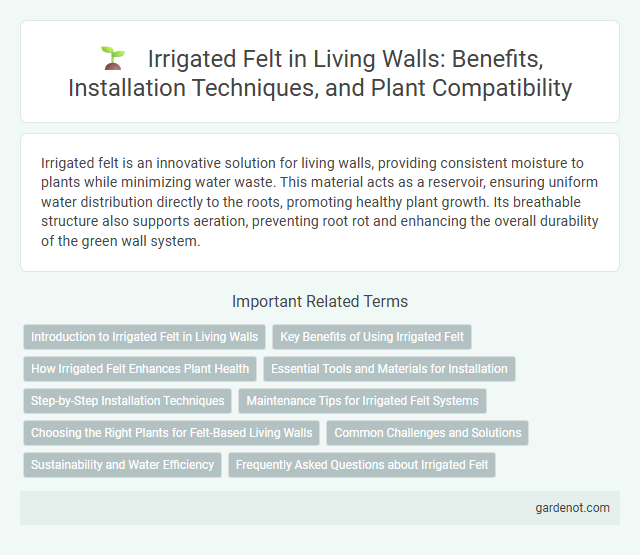Irrigated felt is an innovative solution for living walls, providing consistent moisture to plants while minimizing water waste. This material acts as a reservoir, ensuring uniform water distribution directly to the roots, promoting healthy plant growth. Its breathable structure also supports aeration, preventing root rot and enhancing the overall durability of the green wall system.
Introduction to Irrigated Felt in Living Walls
Irrigated felt is a specialized growing medium used in living walls, designed to retain moisture while providing optimal aeration for plant roots. This felt material ensures consistent water distribution through capillary action, promoting healthy plant growth and reducing irrigation frequency. Its porous structure supports nutrient absorption, making it ideal for sustainable vertical garden systems.
Key Benefits of Using Irrigated Felt
Irrigated felt enhances living walls by providing consistent moisture retention and efficient water distribution, promoting healthier plant growth and reducing water waste. This material supports root aeration and prevents soil erosion, leading to longer-lasting, vibrant vertical gardens. Its lightweight, durable nature simplifies installation and maintenance, making it ideal for sustainable urban greening projects.
How Irrigated Felt Enhances Plant Health
Irrigated felt provides consistent moisture distribution directly to plant roots, reducing water stress and promoting optimal growth conditions in living walls. The felt's porous texture ensures excellent water retention while allowing excess moisture to drain, preventing root rot and fungal diseases. Its efficient hydration system enhances nutrient uptake, resulting in healthier, more vibrant plants in vertical gardens.
Essential Tools and Materials for Installation
Irrigated felt is a crucial component in living wall installations, providing both moisture retention and filtration for plant roots. Essential tools for installation include a staple gun for securing the felt, irrigation tubing for water distribution, and waterproof membranes to protect underlying structures. Materials such as high-quality felt with appropriate thickness and durability ensure efficient water flow and longevity of the living wall system.
Step-by-Step Installation Techniques
Irrigated felt installation for living walls begins with securely mounting the waterproof backing to the structure, ensuring proper alignment and tension. Next, the felt panels are carefully attached using specialized staples or clips, allowing for efficient water distribution through integrated irrigation tubing. Finally, the irrigation system is connected, tested for uniform moisture delivery, and plants are installed to maximize growth and sustainability.
Maintenance Tips for Irrigated Felt Systems
Maintaining irrigated felt systems requires regular inspection to prevent clogging and ensure uniform water distribution. Flush the irrigation lines periodically to remove sediment buildup and replace worn felt layers to maintain optimal moisture retention and plant health. Monitoring the system's moisture levels with sensors helps avoid overwatering or drying out, enhancing the durability and efficiency of living walls.
Choosing the Right Plants for Felt-Based Living Walls
Selecting plants for irrigated felt-based living walls requires a focus on species with strong root systems and moderate water needs to prevent oversaturation. Succulents, ferns, and air plants thrive well due to their adaptability to the felt's moisture retention properties and efficient nutrient absorption. Prioritizing drought-tolerant and low-maintenance plants ensures longevity and vibrant growth in vertical garden installations.
Common Challenges and Solutions
Irrigated felt in living walls often faces challenges such as uneven water distribution, leading to dry spots and plant stress. Maintenance involves regularly checking irrigation systems and optimizing water flow to ensure consistent moisture throughout the felt. Implementing automated irrigation controls and using high-quality felt materials can significantly improve water retention and overall plant health.
Sustainability and Water Efficiency
Irrigated felt in living walls enhances sustainability by reducing water consumption through efficient moisture retention and slow water release. Its porous structure minimizes runoff and evaporation, promoting healthier plant growth with less water waste. This eco-friendly irrigation method supports urban biodiversity and conserves water resources in green building designs.
Frequently Asked Questions about Irrigated Felt
Irrigated felt is a key component in living wall systems, designed to provide consistent moisture distribution for plant roots. Frequently asked questions often address its water retention capacity, compatibility with various plant species, and maintenance requirements. Understanding how irrigated felt supports optimal hydration can enhance the longevity and health of vertical garden installations.
Irrigated felt Infographic

 gardenot.com
gardenot.com